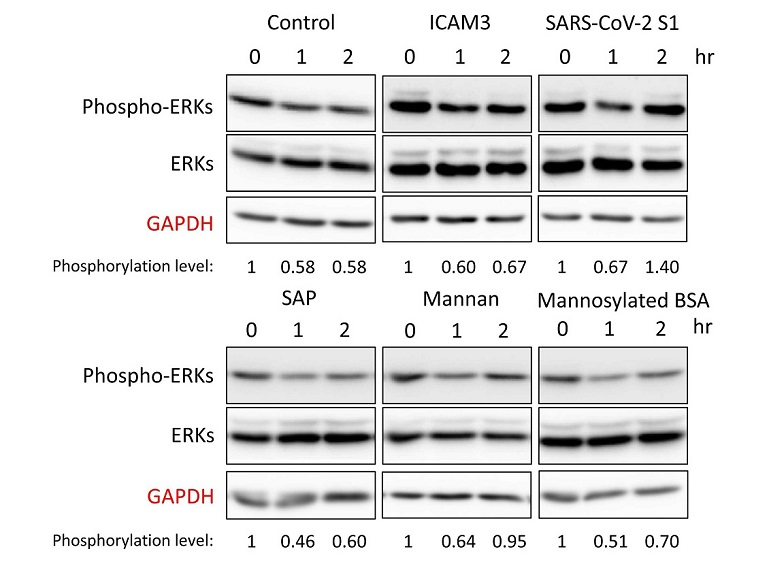SARS-CoV-2 S1 Spike Protein Upregulates ERK/MAPK Signaling Pathway In DC-SIGN-Expressing THP-1 Cells
Nikhil Prasad Fact checked by:Thailand Medical News Team Mar 11, 2024 1 year, 9 months, 2 weeks, 20 hours, 3 minutes ago
COVID-19 News: In the ongoing quest to comprehend the complexities of SARS-CoV-2 infection, researchers from the Osaka International Cancer Institute-Japan and Osaka University Graduate School of Medicine-Japan have unveiled a novel aspect of the viral interaction with host cells. The focus of their investigation that is covered in this
COVID-19 News report, lies in the interaction between the S1 spike protein of SARS-CoV-2 and the ERK/MAPK signaling pathway in DC-SIGN-expressing THP-1 cells, shedding light on the intricate molecular mechanisms at play.
 SARS-CoV-2 S1 Spike Protein Upregulates ERK/MAPK Signaling Pathway In DC-SIGN-Expressing THP-1 Cells
SARS-CoV-2 S1 Spike Protein Upregulates ERK/MAPK Signaling Pathway In DC-SIGN-Expressing THP-1 Cells
The phosphorylation level of ERKs in THP-1 cells after incubation with DC-SIGN-targeting molecules. (A) Representative results of Western blotting indicating the phosphorylation level of ERKs. After incubation with PMA and IL-4, THP-1 cells were subsequently incubated with recombinant ICAM3, SARS-CoV-2 S1, serum amyloid P (SAP), mannan, or mannosylated BSA for 1 and 2 hr. Then, the cells were lysed, and the 20 µg of total proteins were analyzed. The band intensities of phospho-ERKs relative to total-ERKs were measured, and they were normalized to the control results. GAPDH is a loading control. (B) The phosphorylation levels of ERKs in three independent experiments are summarized.
Understanding C-Type Lectin Receptors and DC-SIGN
C-type lectin receptors, comprising over 1,000 proteins with C-type lectin-like domains, are crucial components of the innate and adaptive immune systems. These receptors, expressed in dendritic cells, macrophages, and other antigen-presenting cells, play a vital role in recognizing pathogen-associated molecular patterns (PAMPs) and damage-associated molecular patterns (DAMPs). Among these receptors, the Dendritic Cell-Specific Intercellular adhesion molecule-3-Grabbing Non-integrin (DC-SIGN) has emerged as a key player.
DC-SIGN is known for its ability to bind to various pathogens, including HIV gp120, the Ebola glycoprotein, Hemagglutinin, dengue virus glycoprotein, and the S1 spike protein of SARS-CoV-2. This interaction triggers antigen-presenting cell endocytosis and immune escape from systemic infections. Despite extensive studies on the binding of SARS-CoV-2 spike protein with glycans, the underlying intracellular signaling mechanisms have remained elusive.
The Role of DC-SIGN in Cellular Signaling Pathways
While angiotensin-converting enzyme 2 (ACE2) is recognized as an entry receptor for SARS-CoV and SARS-CoV-2, the expression of ACE2 in certain tissues, such as lung epithelial cells, is low to undetectable. This suggests the existence of alternative receptors for SARS-CoV-2 entry into specific human cells. DC-SIGN, lacking immunoreceptor tyrosine-based activation motif (ITAM) and immunoreceptor tyrosine-based inhibitory motif (ITIM), utilizes tyrosine kinase, the RAS/RAF pathway, and NF-κB pathway for signal transducti
on.
The study aimed to elucidate the integrative signaling pathway generated by DC-SIGN, focusing on the ERK/MAPK pathway in DC-SIGN-induced human monocytic leukemia cells, specifically THP-1 cells.
Experimental Insights
The researchers induced the expression of DC-SIGN in THP-1 cells through differentiation with phorbol 12-myristate 13-acetate (PMA) and interleukin-4 (IL-4). The presence of both PMA and IL-4 was essential for robust DC-SIGN expression, as confirmed through Western blotting and immunocytochemical staining.
The study then explored the impact of various molecules, including ICAM3, S1 spike protein of SARS-CoV-2, serum amyloid P (SAP), mannan, and mannosylated BSA, on the phosphorylation level of extracellular signal-regulated kinases (ERKs) in THP-1 cells. Notably, the S1 spike protein induced a sustained phosphorylation of ERKs, suggesting a direct correlation between SARS-CoV-2 infection and ERK/MAPK signaling activation in DC-SIGN-expressing THP-1 cells.
Discussion and Implications
Dendritic cells, integral to the balance between immune tolerance and induction of immunity, play a crucial role in distinguishing "self-antigens" from pathogens. The ERK signaling pathway, a key player in cellular functions and often implicated in cancer progression, has been identified as a significant component in the immune responses mediated by dendritic cells.
The study highlights the intricate interplay between the highly glycosylated S1 spike protein of SARS-CoV-2 and the ERK signaling pathway. While the S1 protein region carries multiple N-glycans, including mixed oligo-mannose types and hybrid types, the study emphasizes that glycan recognition alone is not sufficient for ERK signaling induction. The amino acid sequence of the non-self-pathogen, along with the glycan, appears crucial for transducing ERK signaling in DC-SIGN-expressing THP-1 cells.
NF-κB signaling, a central pathway for immune responses in dendritic cells, remains an alternative pathway regulated by DC-SIGN. Further investigations are warranted to unveil the intricate recognition and transduction machinery employed by DC-SIGN, providing valuable insights into the immune responses against SARS-CoV-2 infection.
Conclusion
In unraveling the complexities of SARS-CoV-2 infection, the interaction between the viral S1 spike protein and the ERK/MAPK signaling pathway in DC-SIGN-expressing THP-1 cells emerges as a crucial piece of the puzzle. This study contributes significantly to our understanding of the molecular mechanisms underlying immune hyperactivation during SARS-CoV-2 infections, paving the way for potential therapeutic interventions targeting these pathways. As the global scientific community continues its efforts to combat the ongoing pandemic, such detailed insights prove invaluable in the quest for effective treatments and preventive strategies against COVID-19.
The study findings were published in the peer reviewed journal: Cell Stress and Chaperones.
https://www.sciencedirect.com/science/article/pii/S1355814524000543
For the latest
COVID-19 News, keep on logging to Thailand Medical News.
